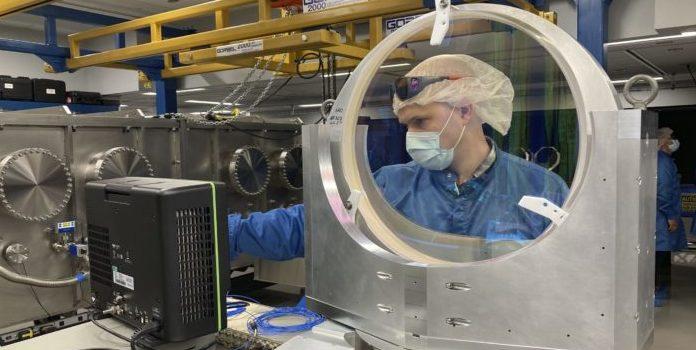(Headline USA) A newly constructed University of Michigan facility that will be home to the most powerful laser in the United States is hosting its first experiment this week as the nation seeks to become competitive again in the realm of high-power laser facilities.
The experiment will be conducted at ZEUS—short for Zettawatt-Equivalent Ultrashort pulse laser System—by researchers from the University of California, Irvine.
They traveled to Ann Arbor as part of their study of extremely intense interactions of light and matter, and how such interactions can be harnessed to shrink particle accelerators.
At the height of its power, ZEUS will be a 3-petawatt laser.
Three petawatts is “3 with 15 zeroes after it,” said Louise Willingale, an associate professor of electrical engineering and computer science at Michigan.
And “3 petawatts is 3,000 times more powerful than the U.S. power grid,” she said.
Michigan was awarded $18.5 million by the National Science Foundation to establish ZEUS as a federally funded international user facility.
Initially, the facility—housed in a building that is home to U-M’s Gérard Mourou Center for Ultrafast Optical Science—will host research teams conducting experiments that use a fraction of the laser’s full power potential. The system gradually will ramp up, and ZEUS is expected to begin its signature experiments in the fall of 2023.
The U.S. built the world’s first petawatt laser a quarter-century ago, but hasn’t kept pace with more ambitious systems in Europe and Asia. While ZEUS doesn’t feature the same raw power as its contemporaries overseas, its approach will simulate a laser that is roughly 1 million times more powerful than its 3 petawatts.
ZEUS primarily will study extreme plasmas, a state of matter in which the electrons have enough energy to escape atoms, creating a sea of charged particles. Nearly all of the seen universe is made of plasma. The sun is an example of a plasma.
Experiments are expected to contribute to the understanding of how the universe operates at the subatomic level and materials change on rapid timescales. Scientists also hope they lead to the development of smaller and more compact particle accelerators for medical imaging and treatment.
ZEUS will “have a huge range of applications across science, technology, engineering and medicine,” Willingale said.
Proposals to use ZEUS will be evaluated by an external panel comprised of scientists and engineers. Because of the NSF funding, there will be no cost to users whose experiment proposals are selected to conduct research, beyond providing their own travel costs to the facility.
The proposals will be selected on scientific merit and technical feasibility, Willingale said.
Franklin Dollar, an associate professor in Cal-Irvine’s Department of Physics & Astronomy, and four UCI graduate students arrived at Michigan last week to begin preparing for their experiment.
“One of the major challenges in our field is access to high quality, intense laser light,” Dollar said. “ZEUS will not only be the most powerful laser beam on the continent, but perhaps more importantly will provide multiple powerful beams.
“Rather than solely making highly energetic plasmas from a laser, there is a second beam which can interact with the plasma as well,” he said.
ZEUS is an upgrade over the University of Michigan’s 0.5-petawatt laser, known as HERCULES.
While Michigan researchers are thrilled with the birth of ZEUS, they are cognizant of how their naming conventions aren’t exactly in keeping with the chronology of Greek mythology.
“HERCULES was the predecessor to ZEUS,” Willingale said. “It’s slightly backward, because Hercules was the son of Zeus.
“So, we’re building the father after the son.”
Adapted from reporting by the Associated Press

